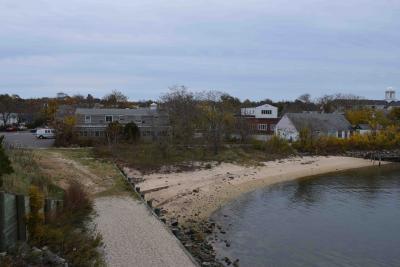Condemnation on Ferry Road

Developers of waterfront property in Sag Harbor Village on the south side of the bridge to Long Beach and North Haven have made it clear they do not intend to sell it to the village for a park. Now the village board is exploring condemnation, a legal process that would allow it to take the properties at 1, 3, and 5 Ferry Road.
During a meeting on Tuesday, the board retained Saul R. Fenchel, an attorney with the Garden City firm of Berkman, Henoch, Peterson, Peddy & Fenchel, who has 35 years’ experience representing clients in eminent domain matters. His website is newyorkeminentdomain.com.
The move toward condemnation comes three months after the Town of Southampton placed the properties on the community preservation fund list, at the request of the village (only towns can administer community preservation funds and Ferry Road is on the Southampton Town side of the village).
Representatives of the owners, which include Greystone Property Development, a Manhattan company, told the town board back in October that they were not interested in selling the property for preservation, and they have subsequently moved forward with plans to develop it.
Reached by phone yesterday, State Assemblyman Fred W. Thiele Jr., the village attorney and chairman of the Southampton Town Independence Party, laid out the process involved should the village pursue condemnation. Quite a lot of preliminary work would be involved, he said, including real estate appraisals, surveys, and the hiring of an engineer to help with the state’s Environmental Quality Review Act process. A public hearing would follow.
An issue, however, is how the village would pay for the property since community preservation fund money cannot be used in condemnations, according to Mr. Thiele. A bond, which the public could be asked to approve by permissive referendum, is one option, while private funding is another. The village could also seek grants from state or federal sources.
Mr. Thiele declined to speculate how much the property may be worth. “It’s a fairly unique piece of property with a checkered history, questions about title, a number of variables that come into play with regard to value,” he said.
Greystone purchased an interest in the parcels, totaling 1.7 acres, for $1.92 million, according to deed transfers dated Aug. 14. It is unclear how much interest the firm holds in the owning partnership, known as East End Ventures, L.L.C.
Mr. Thiele described the procedure that village officials would have to take to proceed toward condemnation. While it would have to determine whether “a valid public purpose for the taking” exists, Mr. Thiele said, “That’s not going to be an issue here. If there’s any valid public purpose, it’s a park.”
Once the village decided to move forward, it would go to State Supreme Court to vest the property and offer the owner what it had determined to be fair market value. The money would be paid to the court, and the property owner would have the option of accepting or challenging the amount. A court proceeding would ensue, and if the owner and municipality could not agree, a judge would make the decision. Regardless of the amount, the village would be on the hook.
“The risk in condemnation is you could acquire the property and the judge could determine the value is different than what your appraisal told you it was,” Mr. Thiele said, noting that the board would have to decide how much risk it is willing to take.
Making matters more complicated, the developers are moving forward with a longstanding condominium project. While the plans have taken several shapes in recent years, the current one is now undergoing the SEQRA process.
“The village board and the planning board have to wall themselves off from each other,” Mr. Thiele said. “The village board cannot influence the planning board in any way, shape, or form,” he said, adding the planning board must proceed. Both he and Denise Schoen, the attorney for the planning board, have advised the boards: “In a phrase, they have to act in good faith."
